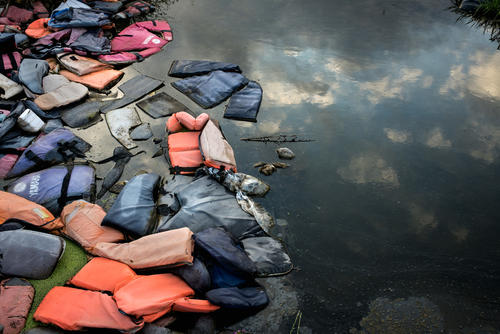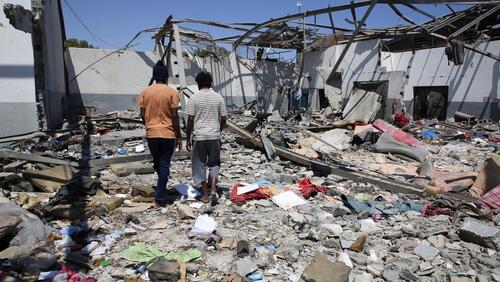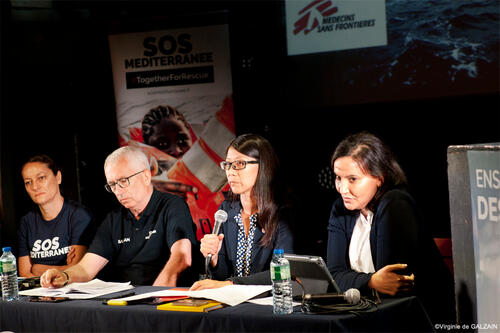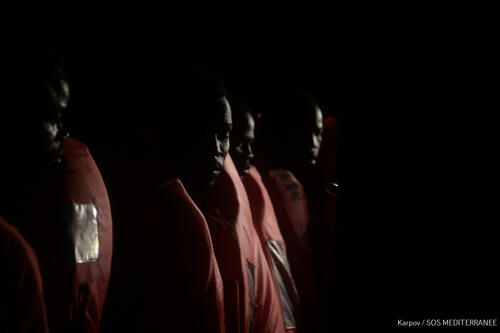Anne-Cecilia Kjaer, MSF nurse activity manager in Libya, describes the scene after the survivors of a shipwreck off Libya, on Thursday 25 July, were brought back to shore in Libya, where our teams assisted them with medical treatment.
“We received a call yesterday in the morning that there were people disembarked at the military base in Khoms. We arrived at around 10.30 am. Our team was made up of one doctor, two nurses and a driver.
There were around 80 people there, mostly from Eritrea, Sudan, Egypt and Bangladesh. It was a very, very hot day. People were sitting against a wall to find some shade. They were barely dressed – some were wearing just a towel or underwear. They were just sitting in the shade, in shock.
We identified critical cases: some had swallowed and breathed in a lot of seawater and were in respiratory distress. Some were quite critical, lying on the ground, looking cyanotic, with grey-coloured skin due to the lack of oxygen. They were in a really bad shape.
Our doctor examined the urgent cases, we set up IV [intravenous] lines and called an ambulance to take them to hospital. In total we referred seven people to local hospitals.
One man from Sudan, who was literally pulled out of the water, told our team that he had seen his wife and kids drown. He seemed aghast, just sitting there in shock.
One man from Sudan, who was literally pulled out of the water, told our team that he had seen his wife and kids drown. He seemed aghast, just sitting there in shock.
When the situation became more stable, we went around to each person in turn to examine less acute medical complaints and distribute water and emergency food. They were so thirsty. Several hours had passed since the boat started sinking and the temperature was around 40 degrees Celsius.
People had small wounds, pains in the stomach from swallowing water, and they were exhausted and traumatised. The ones I talked to had been in the hands of traffickers for a long time and were generally in a bad condition – they looked malnourished and anaemic.
The survivors told us that they had left the Libyan coast on Wednesday evening at sunset, possibly on board three boats lashed to each other. Some said that their boat got damaged, causing water to leak into the boat. They couldn’t complete the journey and tried to turn back. They said they were a couple of kilometres from the shore and the water level in the boat rose.
...the boat started to sink. Most of the children couldn’t swim, and even those who could swim sank because of fatigue.
As they continued towards the shore, the boat started to sink. Most of the children couldn’t swim, and even those who could swim sank because of fatigue.
Eyewitness accounts of those involved in the rescue said that there were at least 70 bodies in the water. The survivors were rescued by fishermen who brought them back to Khoms. Based on testimonies, there had been at least 300 people on the boats, including 50 women and children, and 100 more people on another boat, but we couldn’t confirm this information.
Soon after they arrived in Khoms, another group of 53 survivors were brought to the port. A second MSF team went to the disembarkation point, where they provided emergency assistance.
At 1am, another group of about 190 people was brought to the disembarkation point – they may have been intercepted by the Libyan coastguards. They were mainly from Sudan, Eritrea and Somalia. There was one child.
...they saw their relatives drown, and now they are likely to be put in a prison of some kind, in horrible conditions, or to disappear without a trace in a country at war...
Again, we distributed food and water and did medical check-ups. It wasn’t clear if they had been among the 400 people who left on Wednesday, or if they were part of another group. We are trying to reconstruct the chain of events but hardly any reliable, official information is available. The rescued people are in shock, highly traumatised, and they are basically our main source of information. The people we assisted upon disembarkation have now all left the port but we don’t know their whereabouts.
In the coming days, we will follow up on the seven people we referred to hospital to check on their medical conditions. They cannot be sent to detention centres – they need to be provided with alternative safe housing or to be evacuated to a safe country.
Most of the people I attended to yesterday had experienced such gruesome journeys. These survivors are traumatised and they are going to be put at deadly risk once again. Before surviving the shipwreck, they had crossed the desert, been held captive by traffickers, faced violence and torture.
Then they saw their relatives drown, and now they are likely to be put in a prison of some kind, in horrible conditions, or to disappear without a trace in a country at war, where refugees and migrants are particularly exposed to such alarming and well-known levels of abuses.
I am just very upset and it is very difficult to accept that people who have faced such a level of violence and trauma are being treated like that. It has to stop.
You can’t even imagine how these people are suffering. Once you are in the middle of it – when you try to put words to it – then you realise that there are no words to describe their suffering.”






